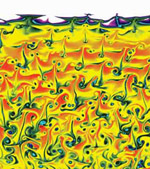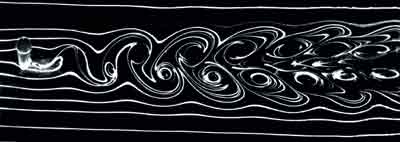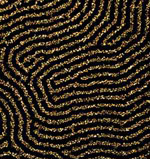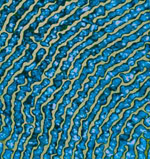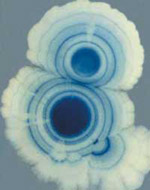 More
and more scientists are studying complex systems. Is a new
field of study arising, or is science simply getting more
complicated?
More
and more scientists are studying complex systems. Is a new
field of study arising, or is science simply getting more
complicated?
There is a funny
dance that some Chicago
physicists and biologists do when the topic of complexity
theory comes up. They squirm, skirt the issue, dodge the
question, bow out altogether unless they’re allowed alternative
terms. They twirl the conversation toward their own specific
research projects: yes, the projects involve systems that
are “rich” and “complicated” and not explained by natural
laws of physics; yes, systems that develop universal structures
which appear in other, completely different systems on a
range of scales; yes, systems that begin with simple ingredients
and develop outcomes that are—there’s no other word for
it—complex.
“The problem with complexity
is that it has become a buzzword,” says Heinrich Jaeger,
professor in physics and the James Franck Institute. “What
do we mean when we say complex? That something
is more complicated than its simple components imply? Why
not say complicated?” he asks. “Complexity
is a newer word, has a better ring. The word itself has
taken on an aura; it’s become a label for a lot of things
to a lot of people.” And that, he says, is a good reason
to avoid it: buzzwords are hard to pin down and therefore
inherently dangerous.
Jaeger’s wariness is well founded. A
lazy woman’s Lexis-Nexis search for complexity theory
attests to the term’s recent popularity. The search brings
up lots of business articles on topics ranging from Southwest
Airlines’ air-cargo system (modeled on the complex swarming
tendencies of ants) to fluctuations in stock prices. An
equally large number of popular-science stories come up,
typically painting an image of a theory to unlock all mysteries.
More often than not these articles cite researchers at the
interdisciplinary, 18-year-old Santa Fe Institute, whose
single-minded insistence that laws of complexity can explain
nearly any phenomenon rankles many an academic.
Yet academics aren’t immune to the fever.
In April 1999 Science magazine ran a special issue
in which distinguished researchers reflected on how “complexity”
has influenced their fields. As evidence of academe’s move
into the realm of the complex, one article cited an academic
building boom in multidisciplinary science centers—including
Chicago’s nascent
Interdisciplinary
Research Building.
This fall’s release of computer-science wunderkind Steven
Wolfram’s tome A New Kind of Science resulted in
a flurry of articles about whether simple, fundamental laws,
as Wolfram argues, can explain all things complex—including
evolution and free will. (Physics Nobel laureate Steven
Weinberg argued in the New York Review of Books
that they most emphatically cannot.
 |
|
Researchers at the
Flash Center
simulate the highly complex interactions within exploding
stars. As shown here, helium on the surface of a neutron
star can burn so vigorously that a detonation wave—a
shock wave followed closely by a burning region—forms,
moving across the star’s surface at 1⁄30 the speed
of light. After 150 microseconds the helium converts
to nickel.
|
|
Judging from the press, complexity theory
is on the verge of, if not already, changing the world.
The buzz is enough to drive many researchers
away from the term. But one Chicago
physicist is more than willing to use the term complexity.
Two years ago he gave the University’s annual Nora and Edward
Ryerson Lecture on the topic, titled “Making a Splash, Breaking
a Neck: The Development of Complexity in Physical Systems,”
and he contributed “Some Lessons from Complexity” to Science’s
special complexity issue. He will name names when asked
who else at Chicago
might provide insight into the rise in studies of complex
systems. (“I know Leo said this is what I study, but...”
is a common conversation starter.)
The “Leo” in question is bright-eyed,
white-bearded Leo P. Kadanoff, the John D. MacArthur distinguished
service professor in physics and mathematics, the James
Franck and Enrico Fermi Institutes, and the College. A National
Medal of Science winner and a founder of the soft condensed-matter
field in physics, Kadanoff has mused over complexity theory
for the past three decades. What he will tell you is that,
despite what the press says, there is no theory—no set of
laws—of complexity. Only lessons and “homilies.”
A definition of the nature of complexity,
Kadanoff says, “has been somewhat elusive.” But if one were
to try, “what we see is a world in which there seems to
be organization built up in some rich and interesting fashion—from
huge mountain ranges, to the delicate ridge on the surface
of a sand dune, to the salt spray coming off a wave, to
the interdependencies of financial markets, to the true
ecologies formed by living things. For each kind of organization,
we want to understand how it arose and whether it has any
general rules associated with it.”
The “metachallenge” in seeking these
rules, he says, is, “What can you learn from one complex
system that you can apply to another? Even though there
are not any laws of complexity, there are experiences that
you can have with one complex system that will help you
study another. Even in systems which are very complex, there
are aspects of their behavior which might be simple and
predictable.”
The job as Kadanoff and others at the
University see it, regardless of their willingness to label
the systems they study complex, is “to reach into these
systems to try to distinguish between the things that are
predictable and not predictable; in the ones that are predictable
to try to pick out the universal features, and then to do
something to characterize the unpredictable parts.”
That’s the driving force behind complexity
studies: to characterize what has for so long eluded characterization.
“Complexity,” reflects physics professor Tom Witten, “is
where a system is more ordered than random because it can
be described in a nutshell. The nutshell might be big, but
you can describe what’s going on. And the more you discover,
the more payoff you get, because you have simplified [what’s
being described] below what it was at the outset. The good
thing is that you’ll never reach the task’s end, and you’re
often rewarded by finding more.
“I never think about whether something
is complex,” Witten
reiterates. “I think about things because they are intriguing—and
wouldn’t it be terrible if I ever got a complete nutshell?”
 |
| Stroboscopic pictures
of a drop of water falling from a pipette. The shape
of the drop's neck is universal, that is, independent
of the experimental setup. Yet there's unpredictability
too: who knows how far the neck will stretch before
it snaps? |
What counts as
a complex—complicated, rich, interestingly organized,
needing-a-big-nutshell—system depends on the eye of the
beholder.
Chicago
researchers study what might seem mundane: how grains arrange
themselves, for example, or how a drop of liquid breaks
apart, or how a surface crumples. And they study what seems
almost overwhelmingly complicated: for example, how an entire
star manages to explode, or how the genomic architecture
of E. coli is naturally programmed to lead the
single-celled bacterium to form colonies and communicate
as a multicellular, highly evolved organism.
The last is the work of biochemistry
& molecular biology professor James Shapiro. Complexity
watchers might have seen Shapiro last year in the New
York Times and the Economist during a minor
media flurry over the founding of the Institute for Complex
Adaptive Matter (ICAM), an independent unit of the Los Alamos
National Laboratory and the University
of California,
Berkeley. He
presented a highly quotable lecture on migration patterns
created by colonies of the bacteria Proteus mirabilis.
The Economist lauded his research for “illuminating
problems as diverse as disease, water treatment, corrosion,
and the formation of certain metal ores.
|
The
Flash Center’s
simulations can reach an unprecedented level of detail,
as demonstrated by these Gordon Bell Prize–winning
results from a full, multiphysics calculation of a
nuclear detonation within an exploding star. |
Biological systems, even physicists agree,
are as complex as a system comes. Although Shapiro, like
most of his colleagues, is wary of the term complexity
theory, he believes the ideas that arise from studying
complexity are opening new realms of study for biologists.
“For the physicist, the properties of
a complex system emerge out of the individual interactions
that compose it,” says Shapiro in his second-floor Cummings
Life Science
Center office—a
block away from the Research Institutes where Jaeger, Kadanoff,
Witten, and
colleagues muse over complex physical systems. “They look
at complexity as systems with many interacting components
and then somehow these systems develop interesting properties.”
He’s right. When Kadanoff refers to the complexity apparent
in the delicate ridge of a sand dune or the salt spray coming
off a wave, he is conjuring the complicated outcomes that
can arise when simple grains of sand or water molecules
are placed under certain conditions: high winds, for instance.
A growing number of biologists, Shapiro
argues, approach complexity from an entirely different angle.
“Biological systems are very complicated and very complex,
but they have clear functionalities. For organisms things
have to be done and done right.” What interests biologists,
he says, is how the organism uses complexity to adapt. “While
the physicist asks, How does complexity generate something
that is describable with pattern to it, the biologist asks,
How does the organism use complexity to achieve its objectives?”
And where physicists are interested in
characterizing the unpredictable outcomes of a complex system—the
magnitude and direction of a sand-dune avalanche, or the
trajectories and sizes of sea-spray droplets—there is a
notable absence of chaos in the systems biologists study.
That fact alone is intriguing. “Why is it that biological
systems are so unbelievably complex but work so reliably?”
asks Shapiro. “Why don’t they undergo chaotic transitions?
What allows biological systems to utilize complexity but
not to be overwhelmed by it?”
Finding the answers, he believes, depends
upon understanding two things: how the large numbers of
components in biological systems interact to create precise
functional behavior, and how basic principles of regulation
and control operate at all levels in living organisms. Applying
those concepts to genetics requires a shift toward what
Shapiro has called “a 21st-century view of evolution.”
The past 50 years of genetic research,
he argues, have provided clear evidence to contradict the
prevailing theory that organisms evolve in a “random walk”
from adaptation to adaptation. Rather, evolution is the
result of “natural genetic engineering”—a highly refined
and efficient problem-solving and genetic-reorganization
process carried out by a genomic architecture that is, he
notes, remarkably similar to a computational system. The
information processing occurs in an organism’s cells via
molecular interactions, and the data on which the processing
runs is stored in the DNA.
|
|
|
Swirls
are universal elements of turbulence, appearing in
exploding stars and, more simply, in fluid flowing
past an obstacle. The result shown above is the characteristic
von Kármán street
pattern. |
Contrary to popular belief, “the character
of an organism is not determined solely by its genome,”
Shapiro maintains. “By itself, DNA is inert.” Instead, survival
and reproduction are the result of how cells’ information-processing
systems evaluate multiple internal and environmental signals
and draw on the data stored in DNA to adapt quickly and
reliably. “Cells have to deal with literally millions of
biochemical reactions during each cell cycle and also with
innumerable unpredictable contingencies,” Shapiro noted
at the 2001 International Conference on Biological Physics
in Kyoto, Japan.
The constantly looming unpredictability doesn’t overwhelm
the system because, as Shapiro explains in a 1997 Boston
Review article, “all cells from bacteria to man possess
a truly astonishing array of repair systems which serve
to remove accidental and stochastic sources of mutation.
Multiple levels of proofreading mechanisms recognize and
remove errors that inevitably occur during DNA replication.”
In fact, cells protect themselves against
“precisely the kinds of accidental genetic change that,
according to conventional theory, are the sources of evolutionary
variability.”
If accidents don’t cause evolution, what
does? The primary perpetrators of evolutionary change, Shapiro
says, are mobile genetic elements—DNA structures found in
all genomes that can shuttle from one position to another
in the genome, cutting and splicing like a Monsanto engineer.
Thanks to these mobile little guys, he notes in the Review,
“genetic change can be specific (these activities can recognize
particular sequence motifs) and need not be limited to one
genetic locus (the same activity can operate at multiple
sites in the genome). In other words, genetic change can
be massive and nonrandom.”
Shapiro’s contribution to the new view
of evolution is to demonstrate that the elements in the
computational genome are universal beyond people, plants,
and animals. Bacterial genomes, his work demonstrates, also
operate and evolve via natural genetic engineering. The
process is not random; it’s in- fluenced by the bacteria’s
experience. Moreover, bacteria experience their environment
not as individual cells oblivious to others in the colony,
but as a multicellular organism. This is evident in the
patterns they create.
“That the patterns exist tells us that
the bacteria are highly organized, highly differentiated,
and highly communicative,” he explains. “In biology when
you see regularity and pattern and control working, you
say, Well, what is it functionally related to, what’s the
adaptive utility for the organism?”
|
|
|
| Heinrich
Jaeger’s MRSEC group attempts to control complexity—first
by understanding how granules “self-assemble” and
then guiding that assembly. One result is these gold
nanoparticle chains on a diblock copolymer template. |
|
These
silver nanowires are the result of allowing the nanoscopic
particles to follow their natural “bootstrapping”
tendencies to clump in rows. Jaeger’s group merely
controls the conditions: the temperature, pressure,
and the template’s chemical makeup. |
On his Macintosh PowerBook Shapiro points
his browser to his Web site, where he’s posted movies of
bacteria colonies growing and migrating. Running in black
and white, the QuickTime films have the scratchy monochromatics
of the silent era. One depicts five E. coli cells
scattered on agar. The squirmy, haloed cells begin growing
and dividing, and then the daughter cells grow and divide,
and soon there are five little colonies surrounded by halos.
“The daughter cells are clearly interacting,” says Shapiro.
“What I am interested in is, are they interacting because
they’re communicating or simply because each cell is internally
programmed independently of the other cell? The way to tell
is by looking at what happens when the scattered colonies
encounter one other.”
The five colonies seem to seek each other
out, growing first toward each other, meeting and merging,
then spreading outward en masse. “The very least you can
say from this observation is that E. coli cells
maximize cell-to-cell contact.” How the cells communicate
with each other—whether they sense a chemical signal, perhaps
in the halo, or a physical signal from the other bacteria—has
yet to be determined. “But that they interact,” says Shapiro,
“is quite clear.”
Another film depicts an E. coli
colony advancing across a petri dish on which a glass fiber
lies diagonally. The edge of the colony moves along until,
boop!, it hits the fiber’s top end. Suddenly the
bugs at the colony’s own top edge are released. They use
their flagella to swim around the fiber, nosing into it
and wiggling vigorously. “According to conventional wisdom
and how they were grown,” says Shapiro, “those individual
cells shouldn’t have been motile.” Meanwhile, the lower
edge of the colony has not yet met the fiber; its slow advance
continues. Shapiro points out that the cells around the
fiber swim and divide but do not spread over the agar; only
the older, organized colony expands over the surface. After
two hours the colony’s lower edge meets the fiber’s lower
diagonal. The colony spends some time on the fiber, filling
in its mass, before eventually spreading past it and continuing
to advance. Yet, rather than being swept up and carried
along like picnic crumbs on the backs of ants, the fiber
remains in place. “That tells you that the whole colony
is not expanding; just the region at the edge is moving
outwards,” explains Shapiro. “There’s a small zone of active
movement, and then everything stays in place.” The colony
expands over the agar not simply by cells dividing and spilling
over; rather, an organized structure is at work.
Shapiro’s movies of Proteus mirabilis
reveal an even more organized growth and migration structure.
In Proteus specialized cells called swarmers are
responsible for colony spreading. After a period of eating
and dividing, the colony releases swarmers outward; the
expanded colony pauses, eats and divides, and eventually
sends more swarmers out. The resulting pattern is a series
of rings similar to a tree’s. Swarmer cells, Shapiro notes,
move only in groups—isolated, they go nowhere—and they do
not divide. Short, fat cells are responsible for cell multiplication.
In a way that may suggest a supercomputer coordinating the
activity of large numbers of interconnected processors,
the expanding Proteus colony coordinates the movement
of large numbers of swarmer cells.
Without the focus on the issues of complexity,
Shapiro believes, biologists would be at a loss to explain
the behavior he’s caught on film. “In biological systems,
at least, trying to understand how the components of these
complicated, complex systems interact and do something adaptive
is central to understanding them at a deeper level and probably,”
he adds, “to understanding all of nature.”
Back the lens out
several hundred thousand light years and expand
the frame exponentially. A neutron star, its surface roiling
in flame and gas—this time in full, glorious color—explodes.
Talk about complex. Now imagine reenacting
it.
That’s what a long row of academic posters
in the fourth-floor hallway of the Research
Institutes Building
on Ellis Avenue
is dedicated to: simulations of the complex interactions
that contribute to a supernova and other exploding stars.
This gallery of fantastic images and nearly incomprehensible
astrophysical explanations is the work of the federally
sponsored Accelerated Strategic Computing Initiative’s (ASCI)
five-year-old Center for Astrophysical Thermonuclear Flashes.
“Part of the challenge—what’s fun—is
to take apart a complicated pattern. There’s an art to this.
It’s not cut and dried; there’s no recipe for a supernova
as yet,” says Robert Rosner, the center’s associate director
and the William E. Wrather distinguished service professor
in astronomy & astrophysics, physics, the Enrico Fermi
Institute, and the College. (Until his October appointment
as chief scientist at Argonne National Laboratory, Rosner
was the center’s director.) “We have to figure out how to
take it apart into simpler pieces. Sometimes we get something
that is, as yet, impossible to understand. The trick is
to get pieces that we can explain and to reassemble these
understood pieces into a whole which we can comprehend as
an explanation of how an evolved star explodes.”
|
Two
E. coli colonies, though grown a day apart,
express similar patterns by turning on and off the
enzyme beta-galactosidase. Their rings’ alignment
tells biologist Shapiro that the periodic enzyme expression
is controlled by a chemical field in the growth medium
and is not intrinsic to each colony.
|
Where the computation metaphor allows
Shapiro to consider bacteria as highly organized, problem-solving
organisms, the nutshells that Rosner’s group wraps around
supernovae are equations that, when crunched, create simulations.
The orgy of brilliant, curving, flaming gases depicted in
“Helium Detonations on Neutron Stars” is one of the largest
nutshells the center has obtained to date. The image (on
pages 38–39) is the result of an integrated calculation,
one that involves many subsidiary calculations conveying
all the smaller complicated interactions and chaos-producing
dynamics. Together they create a massive burst of exploding
helium on the surface of a hypothetical collapsed star that’s
dense with closely packed neutrons. Before the group could
simulate the burst—much less a supernova—it first had to
find the correct equations to describe a detonation, regardless
of whether it occurs in a star or a laboratory.
“We ask first, can we understand these
events in isolation, separate from their environment and
other events? An exploding star, whether a detonation on
the surface of a neutron star or an explosion within a white
dwarf, leading to a supernova, involves not just detonation,
but flames—deflagration—and instability. What happens, for
example, when we put a heavy fluid on top of a light fluid?”
Rosner asks. “If we can answer those questions, we move
up from there.”
A heavy fluid (cold, dense fuel) sinking
into a light fluid (hot ashes) during a nuclear burn—the
so-called Raleigh-Taylor instability, which the center’s
research scientist Alan Calder has modeled—creates turbulence,
or chaotic flow in a fluid, which is physicist Kadanoff’s
speciality. The center’s simulation of the Raleigh-Taylor
instability, an abstract pitching wave of reds, yellows,
and oranges (on pages 44–45), confirms what Rosner, Kadanoff,
and other physicists already know: that the more minute
the detail they try to define in the fluid’s resulting structure
of swirling plumes, the more it eludes them. “The deeper
you look at this thing, it never settles down,” says Kadanoff.
Turbulence, Rosner explains, is a “real-life
exhaustive problem” that presently lies beyond researchers’
predictive abilities. It mystifies them not only in simulations
of stellar bodies but also in understanding how coffee and
cream move when stirred. “The challenge for experimentalists,”
he says, “is to measure at every point the fluid’s temperature,
its flow velocity, and density.” Turbulence lies within
the realm of complexity that at best, as Kadanoff put it,
researchers “do something to characterize.”
The ability to simulate an experiment
and remain faithful to what actually happens, Rosner says,
to look at “fully turbulent” systems, like those in a neutron
star rather than in a coffee cup, and know exactly what
is happening, will “bring simulations to another realm of
experimental science.”
The turbulence problem underscores a
larger point in studies of complex systems. Physical experiments
and equation-crunching simulations must for the foreseeable
future at least maintain a symbiotic relationship. Given
the level of unpredictability in complex systems, using
one without the other is like going blind in one eye: you
lose depth perception.
In his office Heinrich
Jaeger has a poster of a rail yard filled with open
boxcars. The cars are piled high with grain, sloping against
a cornflower-blue sky. Perched on one boxcar’s top edge
is a man reading a newspaper. As the photographer no doubt
intended, the man snags the viewer’s eye, and the grain
piles recede into the background.
But not for Jaeger. What Jaeger sees
are universal elements and unpredictability in those grain
piles. How they pile, what triggers an avalanche, how most
flowed through the chute that shot them into the boxcars,
how some jammed: these are the complex behaviors Jaeger
wishes to describe. While Rosner and Kadanoff think in equations
and at computer screens, Jaeger and his colleagues in the
Materials Research Science and Engineering Center (MRSEC)
work with actual matter: grains, fluids, and various surfaces.
Theirs are the experiments that feed simulations, and the
experiments they conduct aim to reduce a complex system
to its simplest, easiest-to-observe components.
“Much of modern scientific work in pattern
formation and pattern recognition,” Sidney Nagel, professor
in physics and the James Franck Institute, reflects in a
2001 Critical Inquiry essay, “is an attempt to
put what the eye naturally sees and comprehends into mathematical
form so that it can be made quantitative.” Where most viewers
might skim over the monotonous grain piles, Jaeger observes
their patterns and behavior, composing equations to describe
their dynamics; Nagel’s patterns of choice, meanwhile, are
the elongated necks of dripping drops of fluid. “I am seduced
by the shape of objects on a small scale,” Nagel’s essay
continues. “The forces that govern their forms are the same
as those that are responsible for structures at ever increasing
sizes; yet on the smaller scale those forms have a simplicity
and elegance that is not always apparent elsewhere.”
|
Bacteria’s
pattern making reveals their complex nature. Inoculated
at different times, these Proteus mirabilis colonies
remain independent of each other. Although each expands
the same way—swarming and then consolidating—the resulting
concentric terraces, explains biologist James Shapiro,
do not align because each cycle is controlled by internal
population dynamics.
|
For condensed-matter physicists such
as experimentalists Nagel and Jaeger and theorist Witten,
even when objects are reduced to their simplest forms, there
is always an element of wide-eyed wandering. “Serendipity
is OK. A bubbly atmosphere is extremely powerful. The key
is that when you find something good, you need to realize
it,” says Jaeger. “There is no clear goal. But when you’re
awake while wandering around, when you’re paying attention,
and something comes along that’s exciting, you can pick
it up. It’s a high-risk, high-payoff approach—and the preferred
approach if you’re charting territory no one’s been in before.”
It’s the only approach a researcher can
take with complex systems. Jaeger’s granular materials,
from the nanoscale to the scale of marbles, fall in the
realm of complexity (though he prefers complicated)
because they often defy what’s already known in condensed-matter
physics. Taken together, “large conglomerations of discrete
particles,” he and Nagel propose in a 1996 Physics Today
article, “behave differently from any of the other standard
and familiar forms of matter: solid, liquids, and gases,
and [granular material] should therefore be considered an
additional state of matter in its own right.” Nagel’s stretched
fluid necks, similarly, are nonlinear: too many phenomena
are involved to be accounted for in linear equations. Down
the hall Witten
studies the nonlinear behavior of distorted matter: the
crumpling of silver Mylar paper, and on a more minute level,
of polymers packed into a small space.
Once the physicists are set free from
linear reasoning, they can set about seeking the complex
forms’ universals and characterizing their unpredictables.
What Nagel has discovered is that all drops breaking apart,
regardless of their size, experience a “finite time singularity”—their
necks grow infinitely thinner and the forces acting on them
infinitely larger until the infinite becomes finite, and
the neck breaks. The break-up is a universal element repeated
in all drops, of any size and any fluid. Witten,
meanwhile, sees analogous singularities in the peaks and
ridges of a thin crumpled sheet. These singularities do
not develop at a moment in time like Nagel’s. Instead, one
approaches the singular shapes by making the sheets thinner
and thinner. By examining the limiting behavior of these
sheets, he finds universal shapes on scales ranging from
cell walls to mountain ranges. The next nutshell to wrap
around the phenomenon is why and where different-sized ridges
buckle during crumpling; his guess is that the distribution
of various sized ridges and peaks is also universal from
material to material.
| Successfully
calculating complexity and displaying the results are
two different animals. Although the level of detail
achieved in the Flash
Center’s
full simulation of the Raleigh-Taylor instability above
is greater than experiments can capture, even the blown-up
image below can’t show all the detail contained in the
computational data. |
|
 |
These MRSEC experiments and others like
them are the building blocks for simulations created by
Rosner’s and Kadanoff’s groups. “Simulators,” Rosner notes,
“solve equations. We must ask, first, Are we solving the
right equations, and second, Are the equations correctly
solved? Experimentalists tell us whether we’re solving the
right equations. Can our calculations produce what the experimentalists
can measure in the lab? The next question is, Can we solve
problems that are produced in nature? Somewhat. But that
answer will change in the coming decade.” (He estimates
that in three years turbulence simulations will be cracked.)
Just as Rosner is still unable to precisely
simulate full turbulence, graduate students in Kadanoff’s
group have been unable to fully simulate all the details
observed in an experiment by Nagel’s graduate students.
Nagel’s team uses strobe photography to capture what happens
in the lab: a fluid placed in a strongly charged electric
field rises in a mound toward an electrode. The fluid comes
to a point, and some motion occurs between fluid and electrode,
resolving itself in a form strikingly similar to a lightning
bolt. After the bolt flashes, in the space between the fluid
and the electrode a spray of fine water droplets—something
like rain—appears. Kadanoff’s group has been able to simulate
only as far as the mound rising to a point; the outcome,
lightning and rain, is still too complex for equations.
“There is a lesson from this,” Kadanoff
noted in his 2000 Ryerson lecture. “Complex systems sometimes
show qualitative changes in their behavior. Here a bump
has turned into lightning and rain. Unexpected behavior
is possible, even likely.”
To study complexity, as Kadanoff has
remarked, is to attempt to say something about the “interesting”
organization of the world around us, to quantify what seems
simple yet defies quantification. It is a search for metaphors
that, like Shapiro’s use of a computation framework, open
new ways of thinking. “When a system transitions from simple
to complex is something that I wouldn’t know how to define,”
Shapiro reflects. “And I think that’s actually a great problem:
how do we distinguish between what we call simple and what
we call complex? Even things that seem simple, when you
look at them in enough detail, they inevitably become more
complex.”
But the idea, Witten
observes, “is that there’s a magic way to say what’s happening,
where once you say one further thing, the rest is simple.
Is that what complexity means, or is that just
the purpose of science?”


![]() Contact
Contact
![]() About
the Magazine
About
the Magazine ![]() Alumni
Gateway
Alumni
Gateway ![]() Alumni
Directory
Alumni
Directory ![]() UChicago
UChicago![]() ©2002 The University
of Chicago® Magazine
©2002 The University
of Chicago® Magazine ![]() 5801 South Ellis Ave., Chicago, IL 60637
5801 South Ellis Ave., Chicago, IL 60637![]() fax: 773/702-0495
fax: 773/702-0495 ![]() uchicago-magazine@uchicago.edu
uchicago-magazine@uchicago.edu



